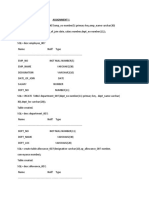0 ratings0% found this document useful (0 votes)
19 viewsTable SQL Data
The document creates two tables, type1 and scd_type1, with type1 containing employee data including a primary key, number, name, job, salary, department number, start date and end date. scd_type1 is also created to contain similar employee attributes.
Uploaded by
kdtftfjggjyhgCopyright
© © All Rights Reserved
We take content rights seriously. If you suspect this is your content, claim it here.
Available Formats
Download as TXT, PDF, TXT or read online on Scribd
0 ratings0% found this document useful (0 votes)
19 viewsTable SQL Data
The document creates two tables, type1 and scd_type1, with type1 containing employee data including a primary key, number, name, job, salary, department number, start date and end date. scd_type1 is also created to contain similar employee attributes.
Uploaded by
kdtftfjggjyhgCopyright
© © All Rights Reserved
We take content rights seriously. If you suspect this is your content, claim it here.
Available Formats
Download as TXT, PDF, TXT or read online on Scribd
You are on page 1/ 1
create table type1(
empkey number(7) primary key,
empno number(4),
ename varchar2(15),
job varchar2(10),
sal number(9,2),
deptno number(3),
start_date DATE,
End_date DATE
);
create table scd_type1(
empkey number(7) primary key,
empno number(4),
ename varchar2(15),
job varchar2(10),
MGR varchar2(10),
HIREDATE DATE,
Comm number(7,2),
sal number(9,2),
deptno number(3)
);
SQL> create table scd_type1(
2 empkey number(7) primary key,
3 empno number(4),
4 ename varchar2(15),
5 job varchar2(10),
6 MGR varchar2(10),
7 HIREDATE DATE,
8 Comm number(7,2),
9 sal number(9,2),
10 deptno number(3)
11 );
Table created.
You might also like
- SQL Exercise-Text Book Table: DepartmentNo ratings yetSQL Exercise-Text Book Table: Department22 pages
- Learning Oracle SQL: Emp - Id Emp - Name Designation Join - Date Supervisor - IdNo ratings yetLearning Oracle SQL: Emp - Id Emp - Name Designation Join - Date Supervisor - Id19 pages
- Creating Company Database Schema and Populating With Data: and Reasoning Behind ConstraintsNo ratings yetCreating Company Database Schema and Populating With Data: and Reasoning Behind Constraints6 pages
- Lab Manual FOR Application Development Software LabNo ratings yetLab Manual FOR Application Development Software Lab49 pages
- Name: Vinayak Nagar Reg - No.: 21MCA0015 Subject: Database Technology Topic: Assignment-1No ratings yetName: Vinayak Nagar Reg - No.: 21MCA0015 Subject: Database Technology Topic: Assignment-177 pages
- KPR Institute of Engineering and Technology: COIMBATORE - 641 407No ratings yetKPR Institute of Engineering and Technology: COIMBATORE - 641 40756 pages
- Advanced Ludo with Excel VBA Code Learn How to Build a Fully Functional Ludo Game from Scratch Using Excel VBAFrom EverandAdvanced Ludo with Excel VBA Code Learn How to Build a Fully Functional Ludo Game from Scratch Using Excel VBANo ratings yet
- AI-powered Excel Ludo: Complete Code and Easy Instructions to Create a Fully Functional, Advanced and AI-powered Ludo Game in Microsoft Excel using VBAFrom EverandAI-powered Excel Ludo: Complete Code and Easy Instructions to Create a Fully Functional, Advanced and AI-powered Ludo Game in Microsoft Excel using VBANo ratings yet
- Blood Group Mobile Number English Dutch: Personal DetailsNo ratings yetBlood Group Mobile Number English Dutch: Personal Details10 pages
- What Is Difference Between TIME and CURRENTNo ratings yetWhat Is Difference Between TIME and CURRENT1 page
- Basic Shell Scripting Interview Questions and AnswersNo ratings yetBasic Shell Scripting Interview Questions and Answers1 page
- Differences Between Stored Procedure and FunctionNo ratings yetDifferences Between Stored Procedure and Function1 page
- Shell Scripting Interview Questions and AnswersNo ratings yetShell Scripting Interview Questions and Answers7 pages
- Unix Interview Questions Leave A CommentNo ratings yetUnix Interview Questions Leave A Comment6 pages
- What Is Bitmap Index Why It's Used For DWH?No ratings yetWhat Is Bitmap Index Why It's Used For DWH?2 pages






































































